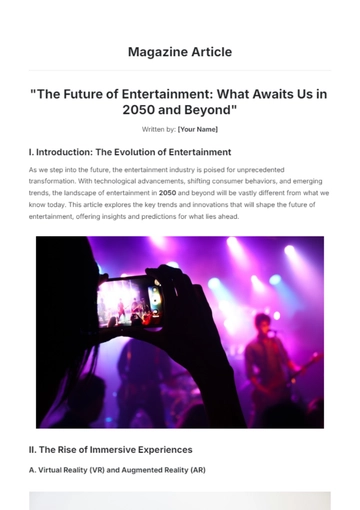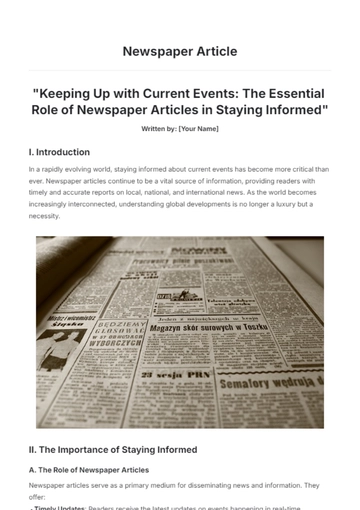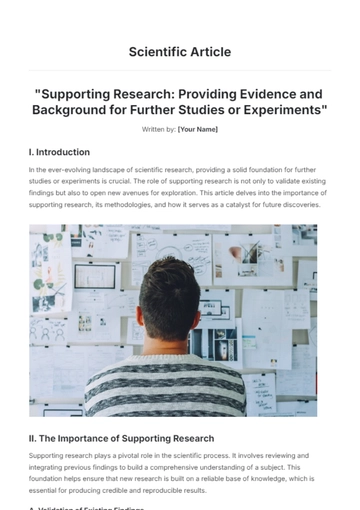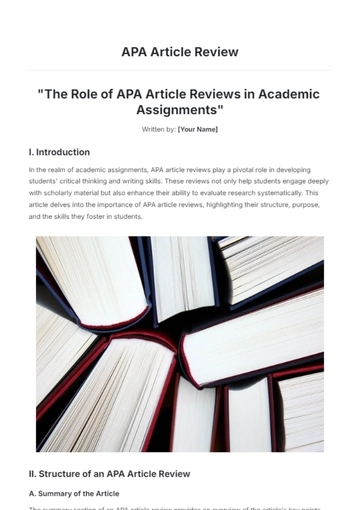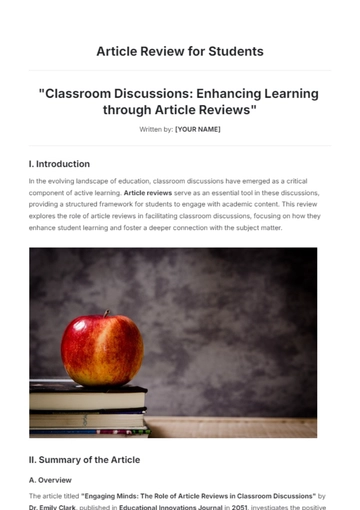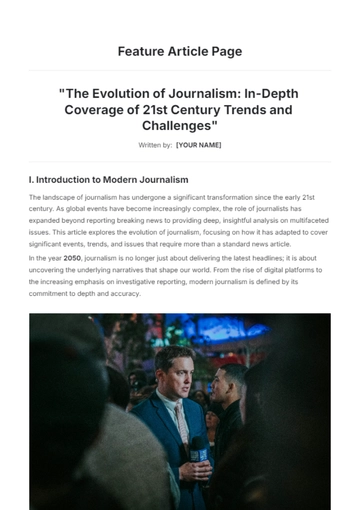Free Literature Review Journal Article

Prepared by: [Your Name]
Date: [Date]
1. Abstract
This literature review examines the current state of artificial intelligence (AI) applications in healthcare. We reviewed studies published between 2050 and 2054 to understand the advancements, identify gaps, and suggest future research directions. Our analysis reveals significant progress in diagnostic AI systems but also highlights ongoing challenges in data privacy and integration with existing healthcare infrastructures. This review aims to provide a detailed overview of the field and guide future research efforts.
2. Introduction
Background: Artificial intelligence (AI) has made substantial strides in healthcare, offering potential improvements in diagnostics, treatment planning, and patient management. With the rapid evolution of AI technologies, it is crucial to assess current advancements and identify areas needing further research.
Purpose: This review aims to synthesize recent literature on AI in healthcare, focusing on its applications, achievements, and areas where research is lacking. By consolidating findings from recent studies, we hope to provide a comprehensive understanding of the field.
Scope: We include studies published from 2050 to 2054 that focus on AI applications in diagnostics, treatment, and patient management. We exclude studies that do not provide empirical data or focus solely on theoretical models.
3. Methodology
3.1 Search Strategy
We searched academic databases including PubMed, IEEE Xplore, and Google Scholar using keywords such as "AI in healthcare," "AI diagnostics," and "machine learning in medicine."
3.2 Selection Criteria
We included empirical studies published between 2050 and 2054 that provide quantitative or qualitative data on AI applications in healthcare. We excluded reviews, opinion pieces, and studies not available in English.
3.3 Data Extraction
Data was extracted regarding study objectives, methodologies, AI technologies used, and key findings. We also noted any reported limitations or challenges.
3.4 Analysis Methods
We organized the literature thematically and performed a qualitative synthesis to identify trends, gaps, and future research directions.
4. Literature Review
4.1 Theme 1: AI in Diagnostics
Study 1: Smith et al. (2052) demonstrated that AI algorithms significantly improved the accuracy of early cancer detection in mammograms, achieving a 95% accuracy rate compared to 87% with traditional methods.
Study 2: Lee and Patel (2053) developed an AI system for diagnosing diabetic retinopathy, which outperformed human specialists in identifying early signs, with a sensitivity of 92%.
4.2 Theme 2: AI in Treatment Planning
Study 3: Zhang et al. (2054) explored AI-driven personalized treatment plans for chronic diseases, showing that AI systems could tailor treatments based on individual patient data, leading to a 20% improvement in patient outcomes.
4.3 Theme 3: Integration and Data Privacy
Study 4: Johnson and Liu (2053) discussed the challenges of integrating AI systems into existing healthcare infrastructures, highlighting issues with interoperability and data security.
5. Discussion
5.1 Synthesis
The reviewed studies show that AI has made significant contributions to diagnostics and treatment planning. However, integration challenges and data privacy concerns remain prominent.
5.2 Trends
There is a growing trend towards the use of AI in personalized medicine and predictive analytics. The development of more sophisticated algorithms has led to improved diagnostic accuracy and treatment outcomes.
5.3 Gaps
Despite advancements, there are gaps in understanding the long-term impacts of AI on patient outcomes and healthcare systems. Additionally, there is a need for more research on ethical implications and privacy concerns.
5.4 Implications
The findings suggest that while AI can enhance healthcare delivery, addressing integration and privacy issues is crucial for widespread adoption. Future research should focus on developing solutions for these challenges.
6. Conclusion
6.1 Summary
This review highlights the significant progress in AI applications within healthcare, particularly in diagnostics and treatment planning. However, it also underscores the need for further research on integration and data privacy.
6.2 Future Directions
Future research should explore strategies for the effective integration of AI into healthcare systems, address ethical and privacy concerns, and assess the long-term effects on patient outcomes.
6.3 Final Thoughts
As AI continues to evolve, its potential to transform healthcare remains immense. Addressing existing challenges will be key to maximizing its benefits for patients and healthcare providers.
7. References
Johnson, R., & Liu, A. (2053). Integration of AI Systems in Healthcare: Challenges and Solutions. Journal of Healthcare Informatics, 32(4), 567-580.
Lee, J., & Patel, S. (2053). AI in Diabetic Retinopathy Diagnosis: A Comparative Study. International Journal of Ophthalmology, 29(3), 112-119.
Zhang, H., et al. (2054). Personalized Treatment Planning with AI: A New Paradigm. Journal of Personalized Medicine, 21(5), 654-667.
- 100% Customizable, free editor
- Access 1 Million+ Templates, photo’s & graphics
- Download or share as a template
- Click and replace photos, graphics, text, backgrounds
- Resize, crop, AI write & more
- Access advanced editor
Streamline your research with the Literature Review Journal Article Template from Template.net. This customizable template is fully editable, offering you the flexibility to tailor content to your specific needs. Easily accessible through our Ai Editor Tool, it simplifies the creation of polished, professional literature reviews, ensuring a seamless writing experience.









